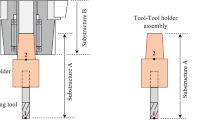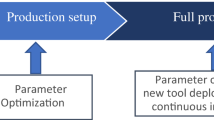Abstract
This paper presents a novel approach to the control of the cutting force on the basis of the internal model control (IMC) principle. The main goal is to control a single output variable, the cutting force, by changing a single input variable, the feedrate. A neural model is used as an internal model to determine the control inputs (feedrate) necessary to keep the cutting force constant. Three approaches, the fuzzy logic controller (FLC), the direct inverse controller (DIC) and the IMC, based on artificial neural networks (IMC-NN), are simulated and their performances are assessed in terms of several performance measurements. The results demonstrate that IMC-NN strategy provides a better disturbance rejection than FLC for the cases analysed.










Similar content being viewed by others
References
Hornik K, Stincheombe M and White H (1989) Multilayer feedforward networks are universal approximators. Neur Ntwks 2:359–366
Hunt KJ, Sbarbaro D, Zbikowski R and Gawthrop PJ (1992) Neural networks for control systems—a survey. Automatica 28(6):1083–1112
Haber RE, Haber RH, Ros S, Alique A and Alique JR (2002) Dynamic model of the machining process on the basis of neural networks: from simulation to real time application. Lect N Comp Sci 2331:574–583
Hagan MT, Demuth HB and De Jesús O (2002) An introduction to the use of neural networks in control systems. Int J Rob Non Contr 12:959–985
Morari M, Zafiriou E (1989) Robust process control. Prentice-Hall, Englewood Cliffs, NJ
Lightbody G, Irwin GW (1997) Nonlinear control structures based on embedded neural systems models. IEEE Trans Neur Ntwks 8(3):553–567
Kambhampati C, Craddock RJ, Tham M and Warwick K (2000) Inverse model control using recurrent networks. Math Comp Simul 51:181–199
Carotenuto R (2001) An iterative system inversion technique. Int J Adapt Contr Sig Process 15:85–91
Lauderbaugh LK, Ulsoy AG (1989) Model reference adaptive force control in milling. ASME J Engin Industr 111:13–21
Rober SJ, Shin YC (1996) Control of cutting force for milling processes using an extended model reference adaptive control scheme. J Manufact Sci Engin 118:339–347
Landers R, Ulsoy A (2000) Model-based machining control. J Dynam Sys Measur Contr 122(3):521–527
Haber RE, Haber RH, Alique A and Ros S (2002) Application of knowledge-based systems for supervision and control of machining processes. In: Chang SK (ed) Handbook of software engineering and knowledge engineering vol. II, World Scientific Publishing, Singapore
Norgard M, Ravn O, Poulsen NK and Hansen LK (2000) Neural networks for modelling and control of dynamics systems. Springer, Berlin Heidelberg New York
Author information
Authors and Affiliations
Corresponding author
Rights and permissions
About this article
Cite this article
Haber, R.E., Alique, J.R. Nonlinear internal model control using neural networks: an application for machining processes. Neural Comput & Applic 13, 47–55 (2004). https://doi.org/10.1007/s00521-003-0394-8
Received:
Accepted:
Published:
Issue Date:
DOI: https://doi.org/10.1007/s00521-003-0394-8




